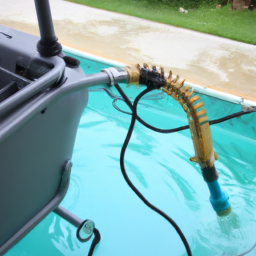How To Use Pool Vacuum With Garden Hose
How To Use Pool Vacuum With Garden Hose
Everything You Need To Know About Using a Pool Vacuum With a Garden Hose
Introduction
Many times, a pool vacuum can be used with a garden hose to make cleaning your pool easy and efficient. Garden hoses are often preferred when cleaning a pool because of their length and powerful water pressure. But the amount of water pressure and the hose's length can determine how effective a garden hose is for using a pool vacuum. In this article, we'll explore the ins and outs of using a pool vacuum with a garden hose, including the historical context, key milestones, popular trends, and potential pitfalls.
Selecting the Correct Garden Hose
The garden hose you select must be long enough to reach all parts of the pool and designed for use with high water pressure. Therefore, it's important to pick the correct length, diameter, and construction material for your hose.
Length
The length of garden hose you choose should be long enough to reach the entire pool and to have some slack for flexibility while maneuvering the hose. Depending on the size of your pool, you'll want to select a hose of at least 50 feet; if your pool is larger, selecting a 100-foot hose could be more beneficial.
Diameter
The diameter of your garden hose should be proportional to the water pressure output of your pool's pump. High-powered pumps typically require hoses with a 1.25-inch diameter, while medium-powered pumps are best used with a 1.5-inch diameter hose. You can determine the correct diameter for your pump by reading the manufacturer's instructions.
Construction Material
Garden hoses are typically constructed from either vinyl or rubber. Vinyl is the most economical choice, but rubber is more durable and can better handle high water pressure. As long as your selected hose has the right diameter and length, the material won't affect the performance of the pool vacuum.
Features of a Good Pool Vacuum
When selecting a pool vacuum, there are a few key features to look out for. Vacuums with adjustable flow and suction control, an adjustable nozzle, and interchangeable brush heads are particularly desirable. Vacuums with these features can give you added control and make cleaning your pool easier and more effective.
Adjustable Flow and Suction Control
Pool vacuums with adjustable flow and suction control allow you to adjust the pressure of the pool vacuum's suction. This can help ensure that the suction is strong enough to pick up dirt and debris from the pool's floor. It can also help reduce the risk of damaging the pool liner.
Adjustable Nozzle
An adjustable nozzle allows you to customize the vacuum to better suit the shape of the pool. With an adjustable nozzle, you can reduce the size of the nozzle to clean tight corners or increase the size to cover wider surfaces. This improves the efficiency of the vacuum and can help make pool cleaning easier.
Interchangeable Brush Heads
Interchangeable brush heads allow you to replace the brush head of the pool vacuum to suit different types of pool surfaces. For instance, you can attach a brush head specifically designed to clean tile or another to clean vinyl pool liners. This feature can save you time in the long run and help keep your pool in top condition.
Potential Pitfalls
When using a pool vacuum with a garden hose, there are some potential pitfalls to be aware of, such as insufficient water pressure, clogs, and damages to the pool liner. Understanding these issues can help ensure that your pool cleaning experience is as smooth as possible.
Insufficient Water Pressure
Inadequate water pressure can cause the pool vacuum to under-perform. This can result in dirt and debris not being fully removed from the pool or the vacuum suddenly losing suction. To avoid this, select a garden hose with sufficient water pressure and ensure that the diameter of the hose is correct for the pump.
Clogs
Clogs can occur if debris gets caught in the vacuum's hose or held up within its body. This can significantly reduce the vacuum's suction power and stop it from operating as it should. To prevent a clog occurring, periodically clean the vacuum and garden hose and check that the filter is regularly replaced.
Damages to the Pool Liner
Using a pool vacuum with too much water pressure can cause damage to the pool liner, such as rips, punctures, and tears. To prevent this, select a garden hose with the correct water pressure and ensure that the vacuum's flow and suction control are set to the right levels.
Insights
Using a pool vacuum with a garden hose is a great way to keep your pool clean and clear. But it's important to select the right equipment and understand the potential pitfalls to ensure the best results. That means selecting a garden hose with the correct length, diameter, and construction material as well as choosing a vacuum with adjustable flow and suction control, an adjustable nozzle, and interchangeable brush heads. Knowing these details can help ensure your pool cleaning experience is as easy and efficient as possible.
Closing Remarks
Using a pool vacuum with a garden hose is a great way to keep your pool clean and efficient. But selecting the right equipment and familiarizing yourself with the potential pitfalls will help ensure the best results. Ultimately, having knowledge of the historical context, key milestones, popular trends, and potential pitfalls can make pool cleaning much easier.

Previous Page
Next Page
